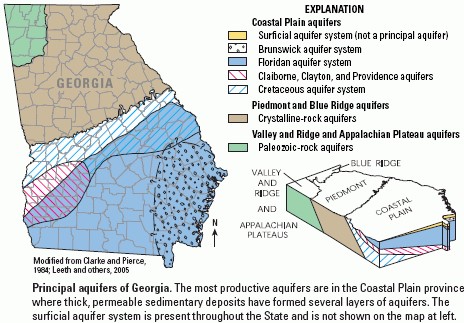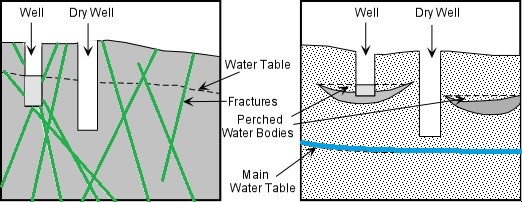Today for National Groundwater Awareness Week, we would like to discuss agricultural water. Most agricultural water, from groundwater, is used in the Southern portion of Georgia. On Sunday of this week, we discussed the different aquifers in Georgia and this is the image we included then.

Most groundwater in Georgia used for agriculture is drawn from the Floridan aquifer (the blue section in the Southern portion of the state). This is a limestone aquifer that has a high transmissivity and water is available in large quantities. In the Piedmont, Blue Ridge, and Valley and Ridge portions of Georgia, agricultural water is typically from surface sources. To better measure and understand the use of groundwater in Georgia used for agriculture, a statewide metering program was started in 2004 and by 2007 growing season enough meters had been installed to get useful data on amount of water being used for agriculture.
Home wells, unlike agricultural wells, do not need as much water flow (100s of gallons per minute in agricultural wells compared to gallons per minute in home wells). On Monday we discussed how we draw water from the aquifer. So, even though the Northern portion of Georgia is Crystalline and Paleozoic rock formations, we can still extract water if the well crosses enough fractures in the rock as shown in the image below. Home wells unlike agricultural wells are not permitted but approximately 95% of rural homes get their drinking water from groundwater wells. Municipal drinking water in South Georgia cities and counties also typically comes from groundwater.

4-H/Youth Yesterday in the posting I mentioned the Edible Aquifer as a fun way to learn about aquifers while also having a dessert. On Wednesday, Ms. Debra Cox, 4-H in Mitchell County Georgia Extension, showed the Edible Aquifer and how to build the aquifer on her Sweet Science Wednesday session. We provided the directions yesterday in the post. Besides the demonstration from Mitchell County, there are also others on the internet.
Family and Consumer Sciences
As mentioned, 95% of rural Georgians get their drinking water from groundwater. If you expect the water from wells is causing issues as mentioned in the post of Tuesday “Testing your well water!”, a sample can be sent to the UGA Agricultural Environmental Services Lab for analysis. See your County Extension Agent to get the bottles and instructions for testing your well water.
Today, I wanted to provide a little information on groundwater usage in Georgia. If you have an agricultural operation and have a pump with a pumping capacity greater than 69 gallons per minute, you will more than likely need an agricultural pumping permit, so contact the EPD Agricultural Pumping Section in Tifton Georgia. If you have a home well, be aware of any changes in the water and I would suggest you start or continue an annual well water analysis. And to have a little fun with aquifers, check out the Edible Aquifer YouTube video.
Today we will look at how groundwater is used in Georgia. We will discuss where we get drinking water, look at the edible aquifer again, and discuss how health issues could be related to drinking water. If you would like to learn more about water resources and well water, the Water Team blog can be found at https://site.extension.uga.edu/water/well-water/ #UGAWater, #UGAExtension
Join us tomorrow as we wrap-up National Groundwater Awareness week.